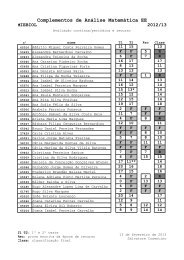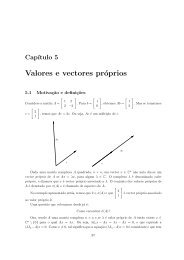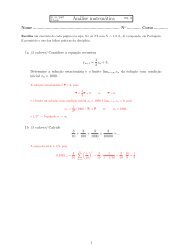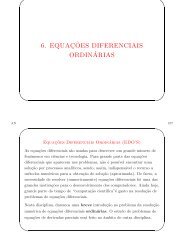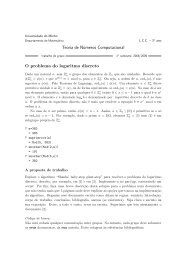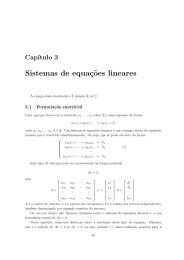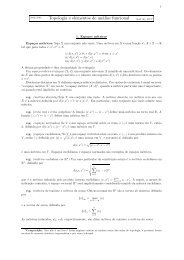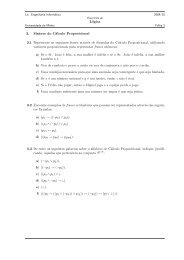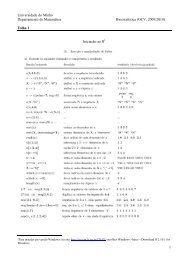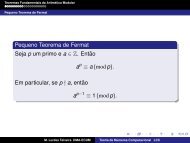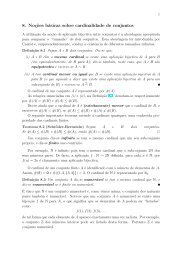My title - Departamento de Matemática da Universidade do Minho
My title - Departamento de Matemática da Universidade do Minho
My title - Departamento de Matemática da Universidade do Minho
Create successful ePaper yourself
Turn your PDF publications into a flip-book with our unique Google optimized e-Paper software.
4<br />
NÚMEROS E DINÂMICA 29<br />
Frações contínuas periódicas e irracionais quadráticos.<br />
são as raizes irracionais <strong>do</strong>s polinómio quadrático<br />
Os números irracionais quadráticos<br />
f(x) = ax 2 + bx + c<br />
com a, b, c ∈ Z, ou seja, os números <strong>da</strong> forma α+√ β<br />
δ<br />
, on<strong>de</strong> α, β, δ ∈ Z, δ ≠ 0 e β > 0 não é um<br />
quadra<strong>do</strong>.<br />
Teorema <strong>de</strong> Lagrange. A fração contínua <strong>de</strong> um número irracional x ∈ R\Q é periódica sse<br />
x é um irracional quadrático.<br />
Dem.<br />
See [Kh35, HW59]. The “if” part is easy, and is suggested in the following exercises.<br />
Exercícios.<br />
• Mostre, por indução, que se x é um irracional quadrático então [a 0 ; a 1 , a 2 , . . . , a n , x] é também<br />
um irracional quadrático, para to<strong>do</strong>s os inteiros a 0 , a 1 , . . . , a n .<br />
• Mostre que para to<strong>do</strong> x ∈ R e to<strong>do</strong>s a 0 , a 1 , . . . , a n inteiros,<br />
com a, b, c, d ∈ Z.<br />
• Observe que se x = [a 0 ; a 1 , a 2 , . . . , a n ], então<br />
[a 0 ; a 1 , a 2 , . . . , a n , x] = ax + b<br />
cx + d<br />
x = ax + b<br />
cx + d<br />
com a, b, c, d ∈ Z, e portanto é um irracional (porque a sua fração contínua é infinita)<br />
quadrático (porque x(cx + d) = ax + b, <strong>do</strong>n<strong>de</strong> cx 2 + (d − a)x − b = 0).<br />
• Deduza que se a fração contínua <strong>de</strong> x é periódica então x é un irracional quadrático.<br />
Rational approximations of irrationals. Rationals are <strong>de</strong>nse in the real line (which is, in<strong>de</strong>ed,<br />
the completion of rationals w.r.t. the Eucli<strong>de</strong>an metric, so that real numbers are equivalence classes<br />
of Cauchy sequences of rationals). Hence, for any x ∈ R and any “precision” ε > 0 we may find<br />
“rational approximations” of x, i.e. solutions p/q of the inequality<br />
∣ x − p q ∣ < ε .<br />
The questions, when x is irrational, are: how large must be the <strong>de</strong>nominator q given ε How <strong>do</strong><br />
the <strong>de</strong>nominators grow when we take smaller and smaller ε <br />
Continued fraction gives the following first answer (but Dirichelet’s proof is much simpler, a<br />
pigeon-hole argument).<br />
Theorem.<br />
Let x be an irrational number. Then there exist an infinity of rationals p/q such that<br />
∣ x − p q ∣ < 1 q 2 .



